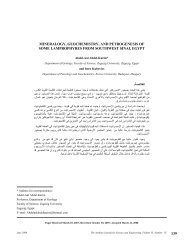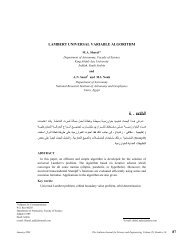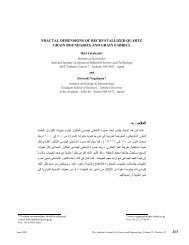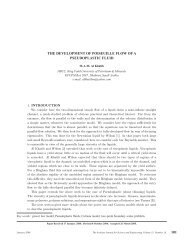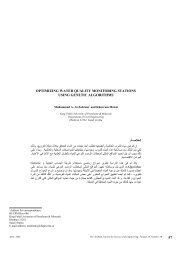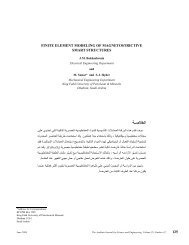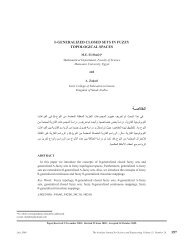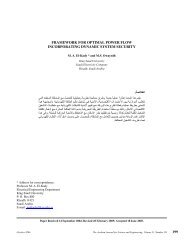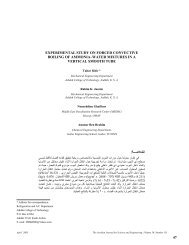HYDRODESULFURIZATION OF THIOPHENE OVER BIMETALLIC ...
HYDRODESULFURIZATION OF THIOPHENE OVER BIMETALLIC ...
HYDRODESULFURIZATION OF THIOPHENE OVER BIMETALLIC ...
Create successful ePaper yourself
Turn your PDF publications into a flip-book with our unique Google optimized e-Paper software.
58<br />
Hamid A. Al-Megren<br />
Normally, the flow rate of hydrogen was 20 ml/min at atmospheric pressure. The activity of nickel–molybdenum<br />
supported catalysts (MECH, IMPR, and OMXC), and thiosophene conversion were studied at a temperature of<br />
350°C<br />
Blank reactor runs were conducted as described above in the absence of catalysts. No significant conversions of<br />
thiophenes were observed under the conditions of each experiment. Carbon mass balancing closed within 8%, most<br />
within 5%.<br />
2.2.1. Gas Chromatography<br />
The analysis of the reaction mixture was carried out using, a Hewlett–Packard 5890 series II. The instrument<br />
equipped with 1 × 1/8" O.D. stainless steel packed column (80 – 100 mesh range Porpak S); and flame ionization<br />
detector (FI), and thermal conductivity detector (TCD).<br />
The instrument was calibrated by external standardization method using standard mixture of (CH4, C2H6, C2H4,<br />
C3H8, C3H6, C4H10, C4H8, and C4H8).<br />
2.3. Catalyst Characterization<br />
Electron probe micro-analyzer (EPMA) (JEOL JXA-8900R/RL) was used for identification of constituent<br />
elements in the prepared samples and to study the elements distribution over the support. Analysis was performed<br />
by illuminating the sample surface with a finely focused electron beam and measuring the wavelengths and<br />
intensities of characteristic X-rays from the specimen and the quantities of secondary electrons and backscattered<br />
electrons from it.<br />
The X-ray diffraction (XRD) was carried out in Philips PW1710 diffractometer with CuKα radiation. The data<br />
were collected at room temperature, in θ/θ reflection mode, scanning the specimen between 3º–70º in 2θ, using steps<br />
of 0.05º, with a time per step of 1.25 s.<br />
The structure of the samples was studied using laser Raman spectroscopy from a Jobin Yvon Labram<br />
spectrometer with a 632.8 nm HeNe laser, run in a back-scattered confocal arrangement. The samples were pressed<br />
in a microscope slide; the scanning time was set to 30s. Raman spectra were recorded in air at room temperature<br />
with a resolution of 2 cm –1 and a scanning range of 100 to 2500 cm –1 .<br />
2.3.1. Physisorption<br />
Nitrogen adsorption–desorption isotherm of MECH, IMPR, and OMXC catalyst samples were measured on a<br />
Micromeretics ASAP2010 system using nitrogen sorption at 77K. Prior to the experiments, approximately 0.2 g of<br />
sample was degassed at 523K for 16h. The surface areas were calculated using a multipoint Brunauer–Emmett–<br />
Teller (BET) model. The pore size distribution was obtained using BJH and BET models and the total pore volumes<br />
were estimated at a relative pressure of 0.99 atm, assuming full surface saturation with nitrogen.<br />
For characterization purpose, samples of the fresh and used catalyst were passivated at room temperature in flow<br />
of 1% O2/He before they were exposed to air.<br />
3. RESULTS AND DISCUSSION<br />
The surface area measurements for the three prepared bimetallic catalyst samples (MECH, IMPR, and OMXC) in<br />
oxide phase, before sulfurization, are shown in Table 1. The surface areas for the samples increase in following<br />
order: MECH (125.5 m 2 /g) > OMXC (122.5 m 2 /g) > IMPR (119.3 m 2 /g); the differences are relatively small. The<br />
highest surface area for the sample prepared by mechanical method could be attributed to less dispersion between the<br />
active component and surface of the support. In Table 1, the average pore diameter and the total volume, measured<br />
for the three samples, were the highest for the samples prepared by mechanical and the lowest for the sample<br />
prepared by combustion method. The particle size distribution analysis shows that the samples prepared by IMPR<br />
and OMXC have almost similar size (~60μm), much higher than the particle size for sample prepared by MECH<br />
(~27μm).<br />
Table 1. Physical Properties of NiMoOx Catalyst Prepared by Impregnation, Mechanical, and Organic Matrix<br />
Methods<br />
Preparation Surface<br />
Method Area m 2 g -1<br />
Total Pore Volume<br />
Cm 3 g -1<br />
Average Pore Particle Size<br />
Diameter A º Distribution μm<br />
IMPR 119.27 0.16529 55.436 59.81<br />
OMXC 122.50 0.16420 53.617 63.53<br />
MECH 125.51 0.18621 59.343 26.81<br />
January 2009 The Arabian Journal for Science and Engineering, Volume 34, Number 1A



